Articles
Thomas Edison, The Battle of the Systems and the Persistence of Direct Current
Abstract
When Thomas A. Edison invented the electric lightbulb and developed the related array of equipment that comprised his direct current electrical system, he provoked a decline in the stock values of urban gas utilities. The lightbulb became a symbol of technological innovation. Soon, however, Edison's system of generating and distributing electricity was challenged by a still newer technology, alternating current. The A.C. system had distinct safety disadvantages, but could be efficient in transmitting over long distances by means of relatively inexpensive wires. There followed a "battle of the systems" during the 1890s as the superiority of the two forms of electrical energy was argued in scientific circles and in the marketplace. By the early twentieth century each had proven its suitability, the one for generation and transmission, the other for distribution and as a power source for motors. By World War I, the optimal situation was a combination of the two systems through which the consumer benefitted from the inherent advantages of each technology.
Résumé
Lorsque Thomas A. Edison a inventé l'ampoule électrique et mis au point l'équipement connexe qui composait son système électrique à courant continu, il a provoqué un déclin des valeurs des stocks dans les usines à gaz des villes. L'ampoule est devenue un symbole de l'innovation technique. Bientôt, cependant, le système de production et de distribution de l'électricité d'Edison a été remis en question par une technologie encore plus nouvelle, le courant alternatif. Le système du C.A. présentait des désavantages marqués sur le plan de la sécurité mais se révélait plus efficace pour transmettre le courant sur de longues distances, au moyen de fils relativement peu coûteux. Au cours des années 1890 eut lieu une « bataille des systèmes » alors que, dans les cercles scientifiques et sur le marché, on discutait de la supériorité de chacune des deux formes d'énergie électrique. Au début du XXe siècle, chacune avait prouvé son adaptabilité, l'une dans la production et la transmission, l'autre dans la distribution et en tant que source d'énergie pour les moteurs. Lors de la Première Guerre mondiale, la situation optimale présentait une combinaison des deux systèmes qui permettait au consommateur de bénéficier des avantages inhérents à chaque technologie.
1 Thomas Edison's development of an incandescent lamp is one of those landmarks in the history of technology that takes a heroic act of invention and makes it the beginning of a new epoch of technological progress. In 1879, in his laboratory in Menlo Park, New Jersey, the famous inventor finally found a filament that would glow for hours as low voltage direct current passed through it. He announced to the press that he had perfected the electric light and the newspapers obliged him by announcing the beginning of the electrical age. Shares of the gas lighting companies plummeted on the stock market.1 The incandescent lamp was no mere incremental improvement in artificial lighting. Like the steam engine before it, the electric light was seen as a harbinger of change, a revolutionary new technology that would drastically alter the pattern of life and work.
2 Edison's famous invention of 1879 was merely the first step in the design of a complete system of electric lighting. In the years that followed, Edison and his band of experimenters produced plans for the switches, conductors, meters, and generators that would constitute the elements of a commercial supply network. This technological system was based on the concept of a central power station. Electricity was generated at one central point in the middle of a city and then transmitted along underground conductors to the homes and offices of users. The completion of the Pearl Street central station in the financial district of New York in 1882 marked the first phase of electrical development: Edison's system of electric lighting was perceived as a viable technology with great commercial potential.
3 The successful operation of this first central power station began a wave of diffusion in which many North American and European companies were formed to duplicate Edison's engineering feat. Copies of the Pearl Street station soon appeared in Boston, Chicago, London, Paris, Berlin and Milan.2 Canadian businessmen who were impressed with the electric lighting systems they had seen in the United States obtained licenses to introduce the new technology into their cities. In this way the electric light spread rapidly throughout North America. By 1890 it was estimated that there were 70 electric light companies in Canada and hundreds of smaller systems in use to bring light to factories and office buildings.3
4 Although it was just a small part of a complex system of electric lighting developed by Thomas Edison, the incandescent bulb captured the attention of the public and became the symbol of the new illuminant. Its wondrous glow demonstrated the miraculous powers of science and technology to onlookers accustomed to gas and tallow flames. The incandescent lamp came to represent the new forces in technology and business that were rapidly changing western cities and urban life. Electricity was a powerful but mysterious force. Although the light could be seen, the electric current was invisible and one did not know that it was even there until contact was made with a live conductor.
Early Safety Measures
5 Edison was well aware of the risk of electric shock and electrical fires when he designed his lighting system. The electricity generated in the Pearl Street system was direct current at the pressure of 110 volts. Edison chose this standard because he found that the light from his incandescent bulb became unsteady and the potency of electric shock increased at higher voltages. The use of high voltages in electric arc lamps used for street lighting at this time was marred by frequent accidents and injuries. Edison was determined to produce a system that would be simple to operate and completely safe — the "safest, most convenient, most efficient" lighting system, and "the only one that is not absolutely injurious to the health of the people using it." The fuse, or "safety wire," he invented for the Pearl Street station became standard in all electrical installations thereafter.4 It was one of his greatest inventions. A simple, automatic cutout device that was virtually foolproof, it was installed in electric lighting systems in homes and businesses. Without it the first installations would have been prone to accident and doomed to failure.
6 Edison always feared that a serious accident involving electricity would ruin his attempts to make the incandescent lamp a household utility. Many of the early utility companies struggled to survive in a highly competitive lighting market in which profits were low and the gas companies were on the offensive against the new competitor. Yet, ironically, the undoing of Edison's electric lighting system came from its great success in the marketplace rather than its failure as a business proposition. Once the public had grown accustomed to the electric light, demand for it quickly outstripped supply. In New York, the inhabitants of the highly populated areas uptown from the Pearl Street station were crying out for electric light but there was no way of getting it to them.
The A.C. Challenge
7 The technological problem in employing the low pressure of 110 volts was that it could not be economically transmitted for more than a mile. Over long distances the copper conductor of the transmission cables had to be increased to such a large size that it was impractical to use them: the high price of copper effectively prohibited long distance transmission of direct current.5 This disadvantage was not a problem when supply systems were small, pilot projects, but as electric utility companies saw that the only way of making a profit was to supply larger areas, a means to send their current over longer distances had to be found. Edison devised an ingenious three-wire system in which a common return wire extended the economic reach of direct current, but it still could not extend the supply radius to distances over about six miles (10 kilometres).
8 A technical answer to this problem was found in alternating current (A.C.). While direct current (D.C.) flows from negative to positive much like water or gas along a pipe, alternating current reverses its flow at regular intervals. Alternating current can be easily transformed from low to high voltages, and higher voltages require a smaller diameter of copper conductor. This made it economically feasible to transmit over long distances. After transmission, alternating current could be stepped down to lower voltages at the point of use. The most practical method of transforming alternating current used the principle of induction. Simply described, induction involves a variation in the current in one coil of wire which causes a current to be induced in a second coil placed nearby. The first commercial transformers were produced in Europe in the 1880s and A.C. lighting systems based on transformers soon followed.
9 In Europe and the United States, the Edison interests remained aloof to alternating current, but other lighting companies did not hesitate to bring out commercial systems. George Westinghouse, an inventor and businessman in the same mold as Edison, thought alternating current had great potential and commissioned research from the inventor William Stanley to perfect a commercial transformer system. The first installation was carried out in Buffalo in 1886, and (according to the Westinghouse Company) many more followed.6
10 Edison had little time to bathe in the glory of his great achievement. In less than 10 years after his invention, the Edison lighting companies were threatened by a new technology. Direct current was soon challenged by a more advanced form of electrical distribution based on alternating current. The wonders of alternating current received an enthusiastic reception in the journals of engineering societies and the trade papers of the electrical industry. Rock bottom prices and extensive promotion by the Westinghouse companies brought rapid diffusion of the new technology as municipal governments and large companies purchased A.C. lighting systems.
The Battle of the Systems
11 In the same way that the gas lighting companies defended their territory against the challenge of a new technology, the direct current interests waged a counter-offensive against alternating current. One of the most colourful episodes in the history of electricity, the "battle of the systems" was fought between the proponents of two competing systems of electrical supply: the Edison low voltage direct current and high voltage alternating current. It took the form of a propaganda war as each side claimed superiority for its technology. Lasting from 1887 to the end of the century, the "battle of the systems" was also a struggle to dominate the next round of electrical development. Winning the battle of words was a prerequisite to selling the larger systems which were to replace the pioneer Edison D.C. systems already established in most of the large cities of the industrial West.
12 The "battle of the systems" was fought wherever business organizations and engineers competed for lighting contracts. A transatlantic information link that had hastened the diffusion of electrical technology also served to bring international attention to what were primarily engineering issues of safety and economy. The central role in the battle played by the world's most famous inventor brought it to the attention of contemporaries, and to subsequent generations of historians.
13 Edison was determined to show that alternating current was dangerous and began an experimental program in his West Orange laboratory to prove his point. His engineers rigged up a powerful alternating current generator and connected the output to a metal sheet. A stray dog was placed on the sheet and subjected to high voltage alternating current until it died. Larger dogs, calves and horses were given the same treatment. Despite cries of foul from the humane societies and the Westinghouse company, Edison did succeed in his goal of demonstrating the danger of high voltage alternating current. These experiments had an important impact on the deliberations of a commission seeking a more efficient and more humane method of capital punishment. The "battle of the systems" marked the first official electrocution.7
14 In his steadfast resistance to a more advanced technology, Edison forfeited his place as the most progressive man of his age. The famous electrocution experiments carried out at Edison's West Orange laboratory provided an unforgettable lesson of the risks of powerful new technologies. Yet the "battle of the systems" also showed how difficult it was to resist the spread of a technological system that represented the highest stage of development. Edison's retirement from the electrical industry was announced in 1892 after the formation of General Electric, a great corporation based on the companies he founded. The new organization wasted no time in manufacturing alternating current equipment.8
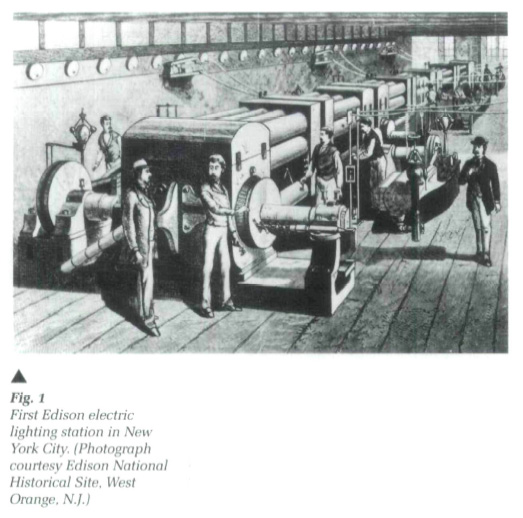 Display large image of Figure 1
Display large image of Figure 115 By the 1890s many electrical engineers were certain that direct current systems would soon be replaced by this improved technology. Described as the supply system of the future in the 1890s, alternating current did indeed become the standard of large-scale electrical distribution in the twentieth century. Alternating current became the basis of much larger lighting systems and brought about a new concept of electricity supply and a completely different technological establishment.
The Modern Power Station
16 Although Edison had invented the central station supply system — an idea he borrowed from the gas companies and their centralized gas holders - the installations based on his Pearl Street model were hardly power stations in the modern sense of the word. The first central stations were small-scale operations in which the electrical generating equipment was installed in a cellar or on one floor of a building (Fig. 1). The Pearl Street station hid behind a narrow shopfront, squeezed in between two other commercial buildings.
17 Alternating current was the means to completely change the scale and the appearance of electrical generation. The long distance transmission capability enabled engineers to build power stations outside city centres in easy-to-supply locations. High voltage electricity could be generated in bulk and transmitted to whole cities. Instead of a small shopfront operation, the central station could become an imposing, self-standing structure that suggested some of the power that was generated within. The prototype of the modern power station was built by the English electrical engineer Sebastian Ferranti in 1888 at Deptford, outside of London. It was intended to generate the electricity to supply one million incandescent bulbs. The voltage of transmission was 10 000 volts alternating current. A new era of electric lighting was to begin at Deptford, the largest central station built to date.9
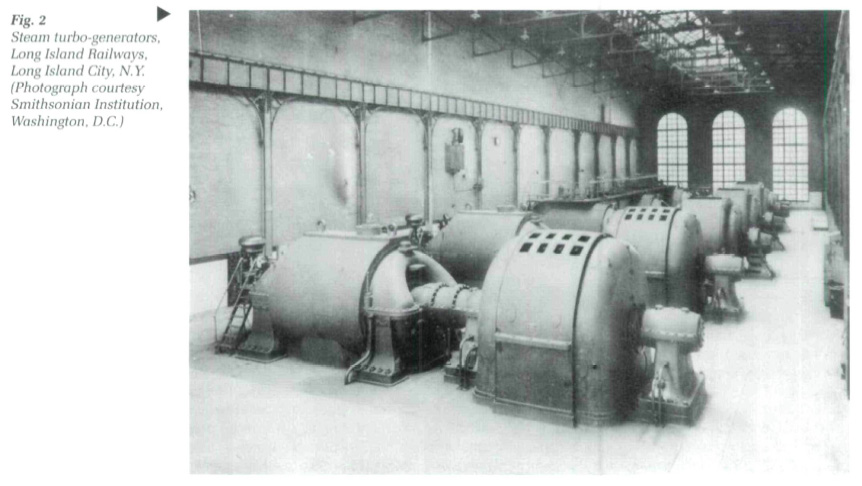 Display large image of Figure 2
Display large image of Figure 218 The small central station modelled on the Pearl Street station, which sat in the middle of its distribution area, was soon replaced by a "super" station that stood outside the city and sent in its current at high voltages. As electric generators grew larger and more efficient, the output of power stations increased along with their size (Fig. 2). The development of the steam turbine brought about a quantum leap in the amount of electricity that could be generated from one station. In North America and Western Europe, utility companies erected enormous structures with multiple chimneys and impressive facades that normally stood on a riverfront location where coal and water could be easily delivered. During the second decade of electric lighting, central stations grew larger and larger as engineers exploited the economic and technical benefits of economies of scale. Electric lighting was therefore given a new face. The incandescent lamp was not forgotten, but it now appeared on advertisements and company stock as an appendage to the mighty power stations that generated the electricity. The central power station became a metaphor for the power of industrial technology, a strong visual image that appeared in magazines and in motion pictures. Fritz Lang's silent movie classic: Metropolis (1926) has the power station at the heart of the futuristic society.
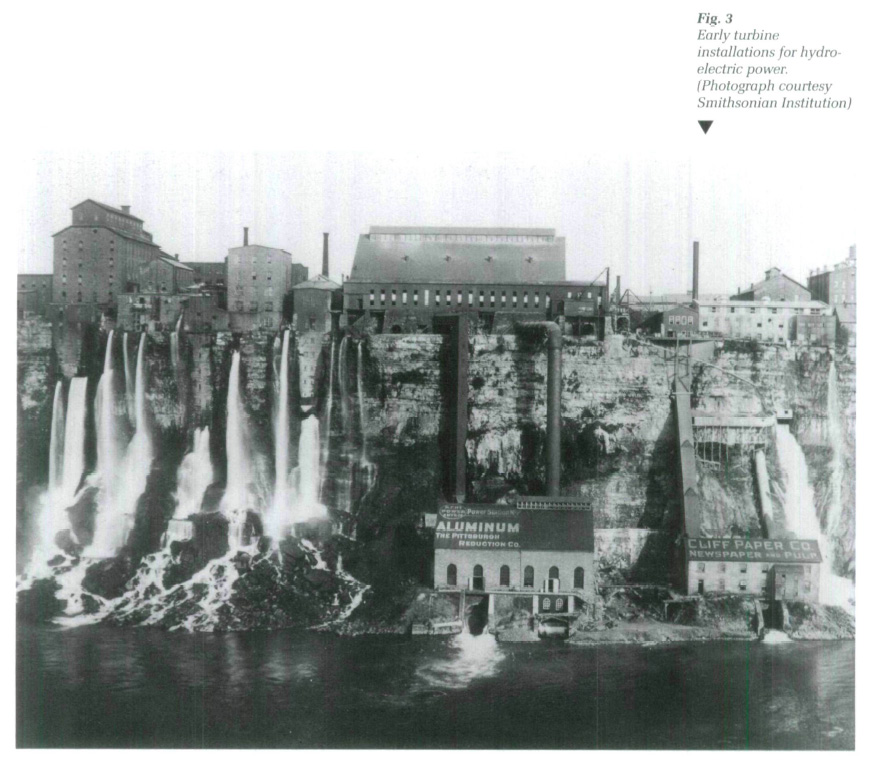 Display large image of Figure 3
Display large image of Figure 3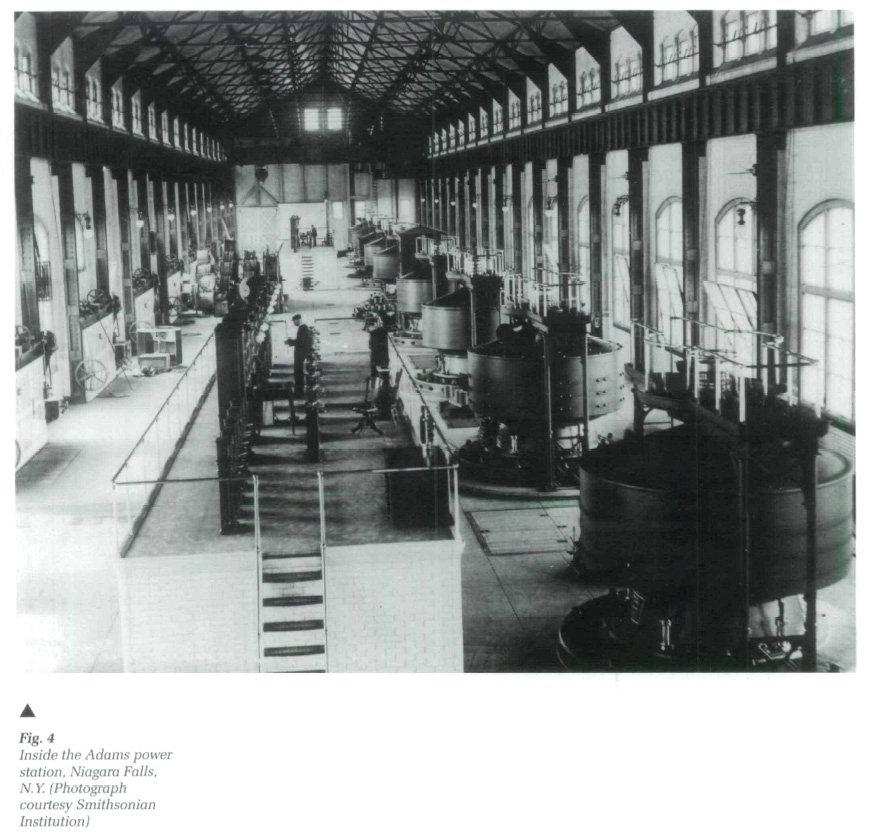 Display large image of Figure 4
Display large image of Figure 4The Birth of Hydro Power
19 The new electrical technology of large power stations and long distance transmission of alternating current made it possible to generate power at one location and send it to cities far distant. It was the means to realize the dream of harnessing the power of waterfalls and in doing so exploit one of the natural world's most impressive works. Even before Edison had actually invented the incandescent light bulb, enthusiastic supporters of the new technology were predicting that one day the Niagara Falls could be used to generate electricity. The New York Sun went as far as to predict that the size of this project would bring about universal and cheap power for the surrounding region.10 Shortly after the announcement of Edison's incandescent bulb the first attempt was made to generate electricity at Niagara Falls.
20 The idea of using water power to generate electricity had been investigated in the earliest days of electrical development when the cost of steam power made electricity very expensive. It was a comparatively easy task to install turbines in flows of water and use them to power dynamos (Fig. 3). Yet it was not until the introduction of alternating current that there was an economical means of transmitting power from a remote waterfall to cities many miles away.
21 An international commission was set up in 1890 to investigate methods of generating and transmitting large amounts of power. Its deliberations led it to consider generating electricity at one of the largest and most spectacular waterfalls in the world. Many electrical engineers and manufacturing companies prepared plans for a hydro-electric power project at Niagara Falls, including Thomas Edison. A plan was finally adopted in 1895 and it became one of the largest engineering enterprises of the nineteenth century. The choice of alternating current equipment to provide the electricity was a great publicity victory for the proponents of A.C. The Niagara Falls project became the formal acknowledgement of the victory of alternating over direct current in the battle of the systems.11
22 The Niagara Falls hydro-electric power project helped to establish confidence in an industry fraught with technical dispute and set a precedent for future electricity supply systems. It was the kind of ambitious project that perfectly reflected the technological confidence of a generation of North Americans who had grown accustomed to turning the forces of nature to their own ends. Where earlier tourists had marvelled at the falling water, many members of this generation were impressed by the engineering works of the power station. When the novelist and futurist H. G. Wells visited the Falls in 1906, he found that the "dynamos and galleries of the Niagara Falls Power Company ... were greater and more beautiful than the accidental eddying of air beside a downpour"12(Figs. 4 and 5).
The Persistence of Direct Current
23 From the vantage point of 1896, the future of electricity supply seemed synonymous with alternating current. The efficient generation of electricity at one central location and its transmission over large areas pointed the way to the large power systems, the power grids of the twentieth century (Fig. 6). Engineers who discussed the technicalities of the A.C. system in their professional meetings were convinced that Edison's direct current system could not contest the economic advantages of the new form of electricity supply. The next decade would surely bring the "supremacy" of alternating current.13
24 Despite the great claims made by the supporters of alternating current, the data from English, German and American electrical journals reveal that direct current was not eliminated from the electricity supply in the years before the Great War of 1914. The yearly accounts published by the Electrical World and the Electrician of London, Electrotechnische Zeitschrift of Germany, and the Electrical Review of New York reveal that alternating current did not make an impact on commercial supply until the late 1890s. Data for the first two decades of the twentieth century show an impressive presence of direct current. The first few years of the new century marked a rapid increase in the sales of electricity in the forms of both alternating and direct current.14
 Display large image of Figure 5
Display large image of Figure 5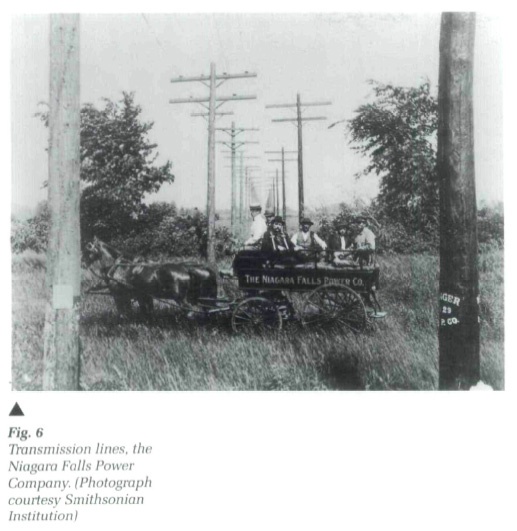 Display large image of Figure 6
Display large image of Figure 625 The reasons for the persistence of direct current are to be found in the institutional and economic framework of diffusion. There could be no doubt that alternating current possessed many technical advantages in theory, but in practice its technical advantages often became disadvantages. The long distance capability that impressed engineers was a severe drawback in the politically charged context of commercial electricity supply. The construction of large supply systems invariably led to the elimination of small local networks owned by municipal governments. The arguments for more efficient distribution systems could not overcome local pride and jealousies. Politicians were more concerned with their loss of power and influence than any gain in the economy of generation. Their independence sealed the fate of Ferranti's Deptford scheme because it denied him the large market needed to support his super power station. The London municipalities were allowed to continue their expensive and inefficient supply, secure and quite content in their technological self-sufficiency.
26 Local governments had a powerful weapon at their disposal: municipal ownership of public utilities. This movement grew in strength in the twentieth century. In the United States it remained a threat to keep electrical supply companies responsive to public concerns, but in Great Britain and Canada it effectively restructured the supply industry. "Public power" was the rallying cry for strict regulation of electricity supply and government supervision of large power schemes.15
27 One of Edison's most valuable discoveries in the early days of electric lighting was that it would always have to exist in a regulated environment. Electricity supply required the construction of a great network of conductors under and over city streets. Electric light was too intrusive to be left solely in the hands of private individuals. The fears of electric, shock from high voltage alternating current was soon translated into stringent regulation that hindered the diffusion of alternating current in North America and brought it to a halt in Great Britain.
28 Edison had criticized the high voltage alternating current equipment of the late 1880s on the grounds of its complexity, unreliability and threat to public safety. As a practical inventor and a shrewd businessman, he was also unimpressed with the economic arguments in favour of A.C. He told a leading financier, Henry Villard, that it was "not worth the attention of practical men," meaning that it had no commercial potential.16 This conclusion was based on his suspicion that too much energy was wasted in transforming current and that A.C. could not provide a cheap and flexible source of power.
The Spread of Electric Power
29 Although most of the attention in the 1880s was on the electric light, Edison considered that the motor load was the profitable part of a central station operation. He decided to build the first power station in a commercial district in downtown Manhattan (instead of the more thickly populated uptown), because he expected that electric lighting could not beat the competition of gas, "but hoped to meet it by selling power."17 The first two decades of electric lighting proved him to be completely right, for electric light was never able to eliminate competition from gas lighting. As a power source, however, electricity reigned supreme. The power load became the most profitable and fastest growing component of central station operation from the late 1880s to the turn of the century.
30 The major reason for the lack of progress of alternating current was a general misunderstanding of the growth of demand for electricity that existed at the time of the "battle of the systems." During the 1890s the profits in the electrical industry were in urban tramways and not the ambitious long distance distribution systems. During the years of the Great Depression of the 1880s and 1890s, only the construction of tramway systems kept the electrical manufacturers and utilities in business.18 Electric power became the foundation for the modern city of skyscrapers and electric tramways. For the masses who could not afford electric light in their homes, the electrically powered street car was their first exposure to the benefits of the age of electricity. Electric elevators and escalators moved people quickly and quietly. The simple combination of a small electric motor and fan made office and factory work more bearable during the summer months. All these applications of electricity depended on the direct current motor.
31 From around 1900 until 1914 the "battle of the systems" concentrated on electric power, especially industrial power.19 The relative merits of the two forms of electric power were hotly debated in the iron, mining and textile industries, as this quarter became the main avenue for economic growth in electricity supply. The introduction of the induction motor in the 1890s gave the alternating current supporters their long awaited electric motor. Although the motor was well received by industry, it was found to be difficult to start and it suffered from low torque. It could not compare with direct current motors in applications that required high torque at the start up, and good control over variable speeds — the two elements most desirable in traction and elevator loads. Industrial users tended to favour direct current for this reason.
32 The importance of traction and urban power loads in electricity supply determined that direct current would not only survive but also prosper into the twentieth century. Even the much admired Niagara Falls project ultimately depended on direct current applications. Its largest customers transformed its high voltage A.C. into D.C. for tramways and urban power.20The 600 volt direct current standard for urban traction schemes that had been established on both sides of the Atlantic during the late nineteenth century proved difficult to change in the twentieth. Edison's three-wire D.C. system at low voltage remained the primary supply network in city centres. The experience of the 1890s and 1900s showed that although it was technically possible to generate large amounts of electricity and transmit it great distances, profits in electric lighting came from dense concentrations of customers. The inner city markets of offices and small businesses favoured by Edison remained the best place to sell electricity at a profit.
The Path to Compromise
33 The "battle of the systems," with its easy differentiation between "obsolete" and "advanced" technologies, fits with the propensity of historians to see technological development — and in turn economic growth — as the advance of new and better technologies. The examples of direct current and of the gas industry before it prove that "threatened men live long," because the incremental improvement of equipment — which is at the heart of technological change — acts on the obsolete as well as the advanced. The relative differences between the performance of alternating and direct current grew less over time as engineers refined and improved each part of the system to bring it towards optimal operation. The development of higher voltages of direct current, with concurrent improvement of commutator technology and turbo-generators, decreased the economic disadvantages of D.C. when compared with A.C. In the same way, engineers produced single phase traction equipment and alternators with commutators to lessen the disadvantages of using power applications of A.C. systems.21
34 Instead of the conflict implied in the term "battle of the systems," the electrical industries on both sides of the Atlantic took the path of compromise. The most practical method of expanding electrical supply was to merge D.C. systems within a greater network of A.C. supply, preserving the dense networks of D.C. usage while economizing on generation. One large central station generated the power and sent it to the smaller central stations which were now used as transformer stations to convert high voltage A.C. into A.C. for use with the lights and motors already in use. "Mixed" A.C. and D.C. systems were the dominant form of electricity supply in the early years of the twentieth century. At this time the "battle of the systems" had become one of all A.C. systems rather than mixed A.C. and D.C. systems.22
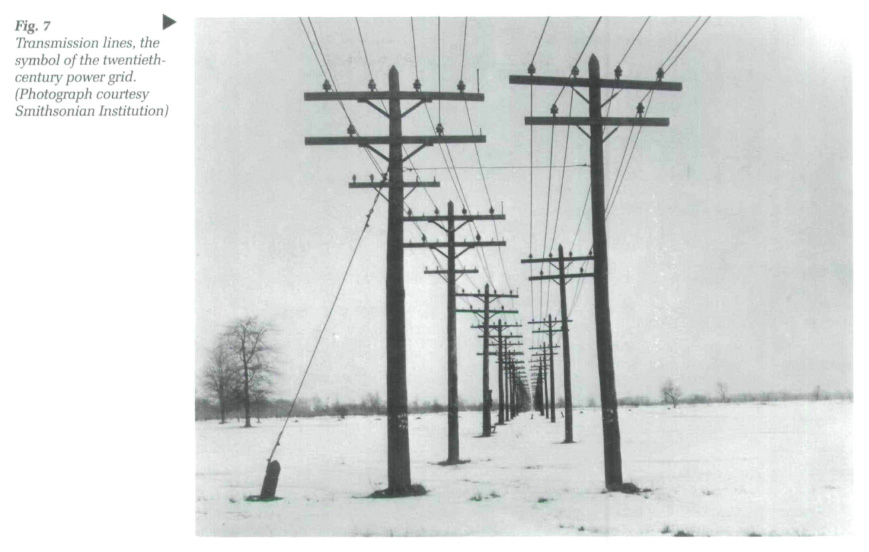 Display large image of Figure 7
Display large image of Figure 735 In 1914 Edison was able to look back at over 25 years of electrical development secure in the knowledge that the system he had originally designed had, with incremental improvements along the way, become the standard for electricity supply.23 His incandescent lamp, although greatly improved, is still with us today and in a form that does not differ significantly from the original 1879 design. The power of the image of tire incandescent bulb has gone beyond the electric light for it has become closely associated with creativity and the act of invention; the sudden illumination of the filament has become the symbol for an idea. In this way, Edison's electric light has remained the most durable of all his inventions.